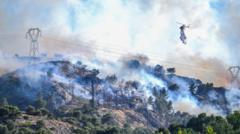*The latest data reveals that carbon dioxide concentrations have surged to record highs, casting doubt on efforts to limit global warming to 1.5C.*
**Record Surge in Carbon Dioxide Levels Raises Urgent Climate Concerns in 2024**

**Record Surge in Carbon Dioxide Levels Raises Urgent Climate Concerns in 2024**
*2024 marks a year of unprecedented heat and rising CO2 levels, challenging global climate goals.*
In what is being characterized as the hottest year on record, 2024 has witnessed an alarming acceleration in the levels of carbon dioxide (CO2) in the atmosphere, with scientists reporting that the gas's concentration has risen more rapidly than ever before. This increase critically threatens the landmark global climate goal of limiting temperature rise to 1.5 degrees Celsius above pre-industrial levels, as pledged by nearly 200 nations during the Paris Agreement in 2015.
According to the UK's Met Office, current CO2 levels have increased over 50% since the onset of large-scale fossil fuel combustion. Fossil fuel emissions have reached record highs in the past year, compounded by adverse natural phenomena like wildfires and droughts, which have hampered the planet's capacity to absorb CO2. "The rapid increase in CO2 is fundamentally incompatible with the international ambition to limit global warming," emphasizes Richard Betts from the Met Office.
Last week, it was confirmed that 2024 has officially surpassed the 1.5C threshold when measured as an annual average, even though this does not immediately breach the longer-term Paris goal established surrounding climate averages over several decades. What this signifies, however, is the pressing need for action as the world's atmospheric CO2 continues unhindered.
Ice core samples and marine sediments show that the current CO2 levels are the highest they have been in two million years. This dramatic rise can be attributed primarily to human activities, specifically the combustion of fossil fuels and widespread deforestation. The previous year's unprecedented CO2 emission rates have also coincided with the onset of the El Niño phenomenon, resulting in warmer sea surface temperatures that affect weather patterns globally.
Recent observations suggest a concerning trend where the natural world may be losing its ability to serve as a carbon sink. Reports indicate that regions like the Arctic tundra are evolving into net CO2 sources due to climate change-driven conditions, and the Amazon rainforest is struggling against deforestation and severe droughts.
Prof. Ralph Keeling from Scripps Institution of Oceanography highlights the urgency of the situation, stating, "These latest results further confirm that we are moving into uncharted territory faster than ever." Preliminary data indicates that CO2 levels rose by nearly 3.6 parts per million between 2023 and 2024 — marking the highest annual increase recorded since environmental monitoring began at Hawaii's Mauna Loa research facility in 1958.
Looking ahead, while the Met Office forecasts a potential slight decrease in the rate of CO2 increase in 2025 due to the transition from El Niño to La Niña conditions, the overall trajectory remains alarming. Betts cautions that despite any temporary respite, CO2 accumulation will continue to drive warming in the years to come.
As climate experts keep a close watch on these developments, awareness and decisive action are increasingly imperative to mitigate the looming threats posed by climate change and ensure a sustainable future for our planet.
According to the UK's Met Office, current CO2 levels have increased over 50% since the onset of large-scale fossil fuel combustion. Fossil fuel emissions have reached record highs in the past year, compounded by adverse natural phenomena like wildfires and droughts, which have hampered the planet's capacity to absorb CO2. "The rapid increase in CO2 is fundamentally incompatible with the international ambition to limit global warming," emphasizes Richard Betts from the Met Office.
Last week, it was confirmed that 2024 has officially surpassed the 1.5C threshold when measured as an annual average, even though this does not immediately breach the longer-term Paris goal established surrounding climate averages over several decades. What this signifies, however, is the pressing need for action as the world's atmospheric CO2 continues unhindered.
Ice core samples and marine sediments show that the current CO2 levels are the highest they have been in two million years. This dramatic rise can be attributed primarily to human activities, specifically the combustion of fossil fuels and widespread deforestation. The previous year's unprecedented CO2 emission rates have also coincided with the onset of the El Niño phenomenon, resulting in warmer sea surface temperatures that affect weather patterns globally.
Recent observations suggest a concerning trend where the natural world may be losing its ability to serve as a carbon sink. Reports indicate that regions like the Arctic tundra are evolving into net CO2 sources due to climate change-driven conditions, and the Amazon rainforest is struggling against deforestation and severe droughts.
Prof. Ralph Keeling from Scripps Institution of Oceanography highlights the urgency of the situation, stating, "These latest results further confirm that we are moving into uncharted territory faster than ever." Preliminary data indicates that CO2 levels rose by nearly 3.6 parts per million between 2023 and 2024 — marking the highest annual increase recorded since environmental monitoring began at Hawaii's Mauna Loa research facility in 1958.
Looking ahead, while the Met Office forecasts a potential slight decrease in the rate of CO2 increase in 2025 due to the transition from El Niño to La Niña conditions, the overall trajectory remains alarming. Betts cautions that despite any temporary respite, CO2 accumulation will continue to drive warming in the years to come.
As climate experts keep a close watch on these developments, awareness and decisive action are increasingly imperative to mitigate the looming threats posed by climate change and ensure a sustainable future for our planet.




















